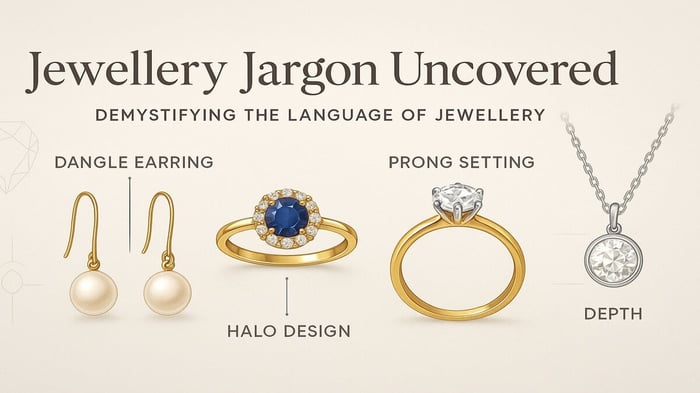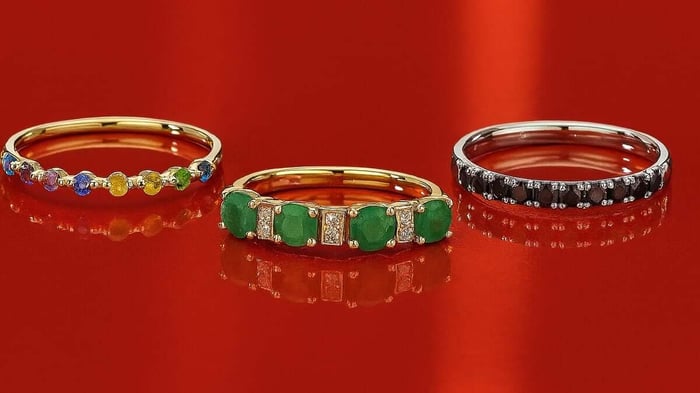Table of Contents
- Metal Purity and Authentication Standards
- Diamond Grading and Quality Measurements
- Understanding Diamond Colour Grades
- Clarity Scale Basics
- Cut Quality Impact
- Essential Gemstone Cuts and Shapes
- Surface Treatments and Special Effects
- Contemporary Metals in Modern Design
- Industrial Alloys Revolution
- Durability Meets Design
- Future Metal Innovations
- Necklace and Chain Terminology
- Chain Link Styles
- Necklace Length Guide
- Clasp Types Explained
- Bracelet Styles and Construction Methods
- Watch Components and Technical Features
- Comfort Features and Wearability Terms
- Our Final Thoughts About Jewellery Jargon
The jewellery industry's specialised terminology includes precise standards that determine value and authenticity. Metal purity ranges from 10K to 24K gold, whereas sterling silver maintains 92.5% purity. The 4Cs system—cut, colour, clarity, and carat—grades diamonds, with colour scales ranging from D to Z and clarity grades from Flawless to Included. Construction techniques include various clasp mechanisms, setting styles, and chain patterns. Understanding this jewellery jargon empowers consumers to make informed purchasing decisions and appreciate craftsmanship subtleties.
Metal Purity and Authentication Standards
The precious metals business operates under strict standards that distinguish genuine materials from clever imitations. Gold purity standards range from 10K containing 41.7% pure gold to 24K at 99.9% purity, whereas sterling silver maintains 92.5% silver content. Each karat designation denotes specific purity levels that manufacturers must maintain to meet certified gold jewellery standards.
Metal testing methods such as fire assays determine gold fineness with remarkable precision, achieving accuracy within 2-3 parts per 10,000. These rigorous purity standards protect consumers from fraudulent alloys, such as silver-copper mixtures falsely marketed as sterling silver.
Authentication protocols include torch tests that distinguish platinum from similar-looking metals through their melting behaviour, and ASTM F2999 compliance guarantees safety standards.
International bodies like ISO/TC 174 govern consistency across borders, making metal testing crucial for legitimate trade and consumer confidence in jewellery purchases.
Certified Diamond Solitaire Engagement Ring 0.70ct E/VS Quality in Platinum
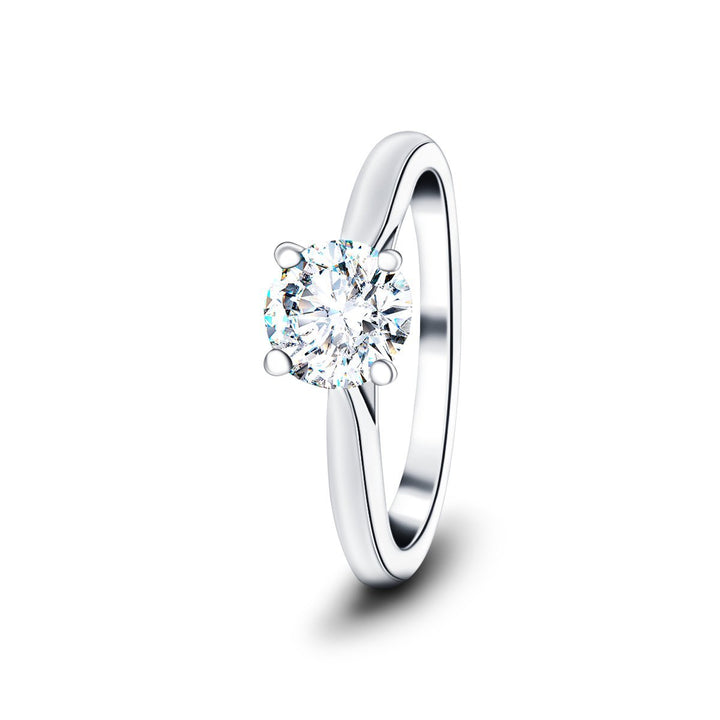
$3,470.00
$5,944.00
Light up the eyes of your special someone with a proposal delivered with this gorgeous diamond solitaire ring in spectacular hand-crafted platinum. Start the next chapter of your lives together in style, your love reflected in the unique beauty of… read more
Diamond Grading and Quality Measurements
Diamond grading relies on standardised measurements across colour, clarity, and cut quality, which together determine a stone's value and appearance.
The colour scale runs from D (colourless) to Z (light yellow or brown), with even minor variations affecting price, whereas clarity grades range from Flawless to Included based on the visibility of natural imperfections. Understanding the Four Cs is essential for consumers seeking to make informed decisions.
Cut quality, perhaps the most essential factor for brilliance, evaluates how well a diamond refracts light through precise angles and proportions, with ratings from Excellent to Poor directly impacting the stone's sparkle and fire.
These three factors, combined with carat weight, form the 4Cs standard created by GIA as a universal method for diamond quality assessment worldwide.
Understanding Diamond Colour Grades
Among the most crucial factors in determining a diamond's value, colour grading stands as a fundamental measurement that evaluates the absence of hue in these precious stones. The GIA's D-to-Z scale transformed grading consistency by replacing fragmented alphabetical systems that confused buyers. This standardisation improved consumer education, allowing purchasers to grasp that D represents colourless perfection while Z indicates light yellow tinting.
Market trends reveal fascinating colour perception patterns. Although colourless grades command premium prices, near-colourless diamonds (G-J) balance quality with affordability. Subtleties between adjacent grades often escape untrained eyes, yet significantly impact pricing. The letter D was deliberately chosen to avoid associations with previous grading systems that used A, B, and C to denote top quality.
Regional preferences likewise shape demand, with some markets favouring mild warmth over absolute colourlessness. Comprehending these intricacies empowers consumers to make informed decisions based on personal preference and budget.
Solitaire Diamond Bracelet 0.25ct G/SI Quality in 18k Rose Gold
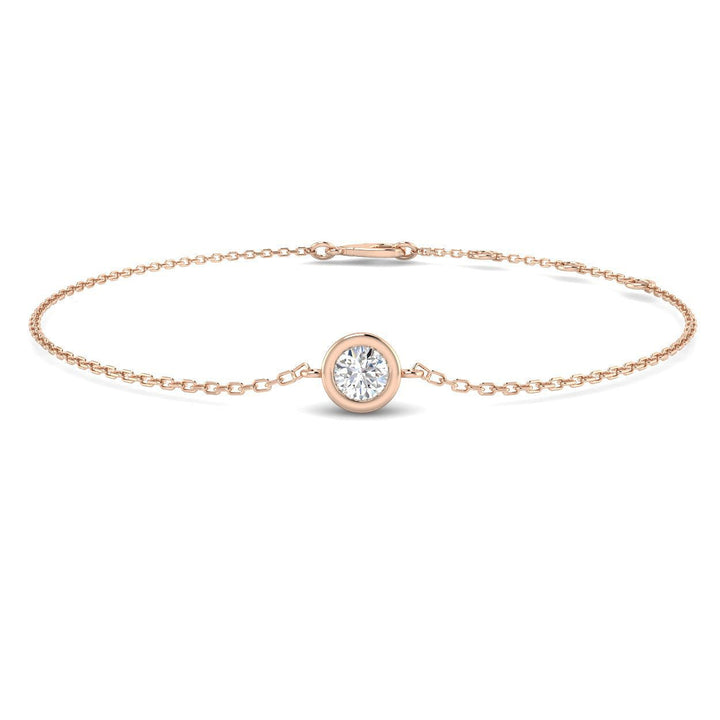
$1,258.00
$1,988.00
This beautiful rose gold bracelet is a great gift for anyone. The attractive bright-coloured rose gold with the beautiful diamond engagement ring really makes this bracelet stand out. The stylish rose gold and the attractive diamond make this item a… read more
Clarity Scale Basics
Clarity grading evaluates the purity of diamonds through an intricate 11-point scale that identifies internal characteristics and surface blemishes. This system encompasses grades from Flawless to Included, with most diamonds falling into VS or SI categories.
Visual assessment relies on 10x magnification, where grading techniques examine inclusion types like feathers, clouds, and crystals. The GIA developed this standardised scale to replace ambiguous terms previously used by jewellers, ensuring consistent grading worldwide.
Diamond clarity depends on various clarity factors: size, quantity, location, and inclusion relief. Pavilion inclusions prove especially problematic since reflective facets amplify their inclusion visibility.
Dark crystals create stronger contrast than white clouds, affecting transparency effects more severely. Grading implications vary significantly between adjacent grades, with VVS diamonds requiring minute flaws barely detectable under magnification.
Clarity comparisons reveal that a single large inclusion often impacts grades more than several tiny ones, making location and nature essential evaluation elements.
Cut Quality Impact
Light transforms into brilliance through the precise angles and proportions of a diamond's cut, making this characteristic the most influential of the 4Cs in determining visual appeal.
Cut impact extends beyond simple measurements, as outstanding light performance requires balanced proportions, symmetry, and polish working in harmony. The GIA evaluates these elements through a universal system that assigns five distinct cut grades to help consumers understand quality differences.
Grading subtleties vary significantly between laboratories, with GIA reserving its highest designations for round brilliants, whereas AGS uses numeric scales across all shapes.
Sparkle trade-offs emerge when weight retention competes with optical efficiency, creating diamonds that appear larger but sacrifice brilliance.
Premium cuts command 10 to 20% price increases since they maximise fire, scintillation, and brightness.
Poor cuts amplify colour deficiencies and create dark zones, which demonstrates why experts prioritise cut quality over other characteristics when evaluating diamonds.
Princess Cut Diamond Bangle 4.00ct G/SI Diamond in 18k White Gold
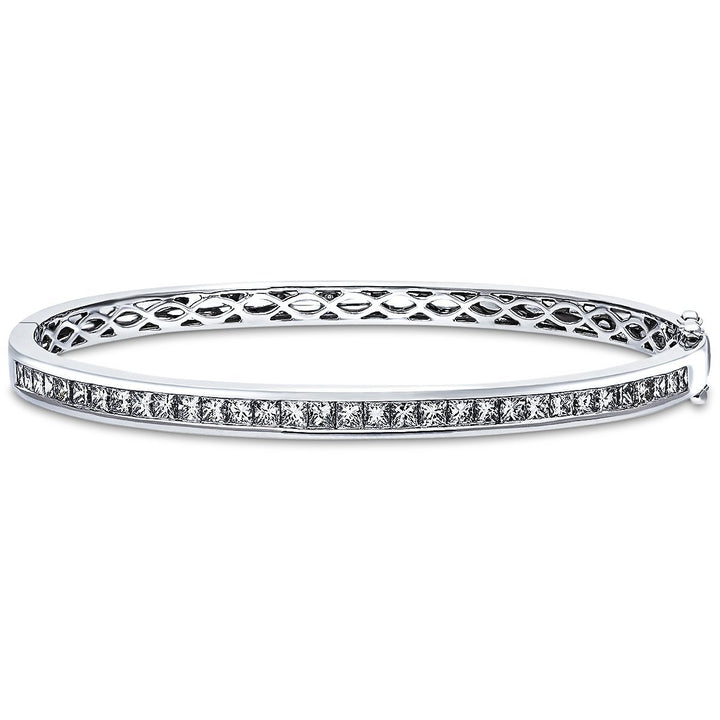
$10,351.00
$18,652.00
The unique Princess Cut Diamond Bangle is a great gift for the woman in your life who appreciates a bit of sparkle. The exceptional 18k White Gold design features a beautiful princess cut diamond set in the centre. This classic… read more
Essential Gemstone Cuts and Shapes
The art of precious stone cutting transforms rough crystals into dazzling jewels through precise mathematical calculations and centuries-old craftsmanship techniques.
Brilliant cuts, featuring triangular facets radiating from the centre, maximise gemstone brilliance through strategic light reflection. These cuts dominate popular shapes like round, oval, and princess designs, each engineered for optimal sparkle.
Step cuts, including emerald and baguette styles, prioritise clarity over brilliance, with parallel rectangular facets arranged in tiers. Cut symmetry remains essential for balanced light performance, particularly in pear and marquise shapes.
Mixed cuts combine both techniques, using brilliant facets on the crown and step facets on the pavilion. Modern trends embrace oval and pear cuts for unique brilliance profiles, while minimalist designs favour emerald cuts for their sleek geometric appeal. Innovative cutters now incorporate curved facets to create fantasy cuts that surpass traditional flat-faceted designs in brilliance.
Surface Treatments and Special Effects
- Advanced polishing progresses through multiple grit levels, culminating in mirror-like or satin finishes.
- Engraving techniques and etching produce intricate designs by carefully removing metal.
- Hammering, sandblasting, and granulation produce dimensional effects with varying depths and patterns.
- Finish contrasts improve visual interest by pairing high-polish sections with matte surfaces or textured areas. These finishes significantly alter the jewellery's appearance through carefully selected texture considerations that enhance each piece's unique character.
These special effects require precision tooling and expertise.
Artistic engraving adds personalisation through custom inscriptions, as well as layered techniques that combine multiple methods for extraordinary results that elevate jewellery from simple adornment to wearable art.
Contemporary Metals in Modern Design
Modern jewellery design has embraced a revolution in industrial alloys, where lightweight aluminium and durable steel now share the spotlight with traditional precious metals, creating pieces that challenge conventional notions of luxury.
These contemporary materials combine exceptional strength with creative freedom, allowing designers to craft larger, more sculptural forms without the weight or cost constraints of gold and platinum. Contemporary metalsmiths featured on platforms like Metalcyberspace showcase how these industrial materials elevate artistic expression beyond traditional boundaries.
As technology advances, future innovations in metal engineering promise even more exciting possibilities, from colour-changing titanium alloys to smart metals that respond to body temperature, positioning jewellery at the intersection of fashion and materials science.
Industrial Alloys Revolution
As traditional precious metals face rising costs and sustainability concerns, contemporary jewellers increasingly turn to industrial alloys that offer extraordinary creative possibilities as they maintain aesthetic appeal and structural integrity.
Modern alloy customisation allows designers to tailor metal properties for specific applications, combining copper, zinc, and nickel in precise ratios. This revolutionises jewellery manufacturing through:
- Sustainable sourcing via industrial recycling processes that reintroduce scrap metal into new alloy mixes
- Enhanced properties like antimicrobial surfaces and superior corrosion resistance through cupronickel compositions
- Safer substitutes replacing toxic base metals like nickel-cadmium with environmentally conscious choices
- These innovations enable jewellers to create pieces that rival precious metals in beauty while offering superior durability and affordability. Advanced CAD software integration accelerates the development of complex alloy-based designs, allowing precise calculation of material properties before production begins.
The shift represents a fundamental change in how contemporary designers approach material selection and production methods.
2.30ct Baguette & Round Cut Claw Set Diamond Cross in 18k Rose Gold
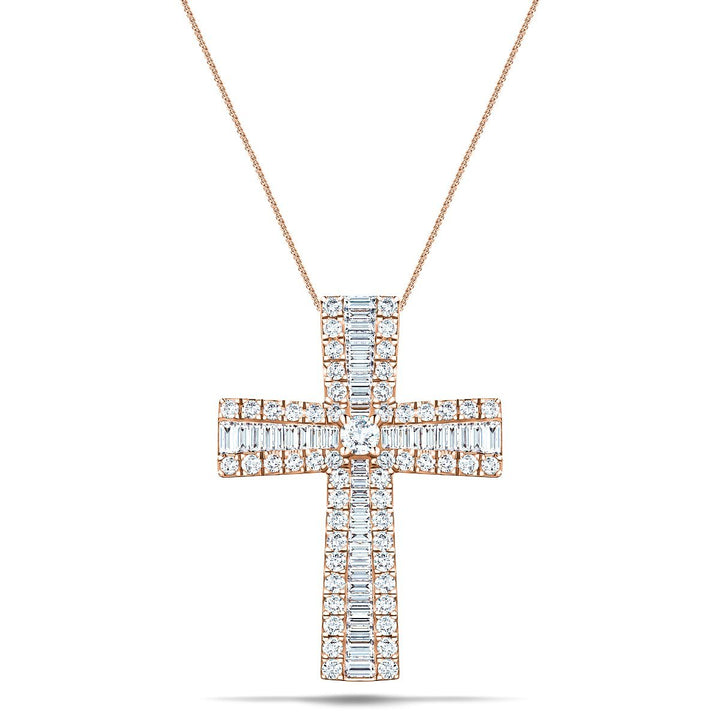
$4,732.00
$7,136.00
This glistening piece of jewellery is sure to make a much-beloved gift. The shimmering women's cross pendant is 18K rose gold and features 2.30ct of ethically sourced G/SI quality diamonds perfectly arranged to catch the light and adds that dazzling… read more
Durability Meets Design
When contemporary jewellery designers balance durability with aesthetic appeal, they create pieces that transcend mere ornamentation to become functional art forms.
Design durability emerges through inventive techniques like electroplating and precision soldering, which improve material resilience while maintaining visual impact. Sterling silver's malleability combines with oxidised finishes to achieve aesthetic longevity, as mixed-metal combinations showcase metal versatility in bold statement pieces.
Sustainable choices drive modern practices, from recycled materials to ethical sourcing of conflict-free precious stones. These environmental considerations extend to metal sourcing, where designers increasingly prioritise suppliers who demonstrate responsible mining practices and transparent supply chains.
The craftsmanship balance appears in asymmetric, nature-inspired forms and societal significance through reimagined traditional patterns. Modular assembly techniques guarantee pieces remain repairable without compromising structural integrity.
These approaches demonstrate how contemporary metalwork achieves both practical resilience and artistic expression, creating jewellery that endures physically and aesthetically.
Future Metal Innovations
Innovation in contemporary jewellery metals transforms traditional expectations of what fine accessories can achieve. Metal advancements like Serinium and tungsten carbide showcase performance improvements through superior scratch resistance, alongside titanium offering lightweight solutions for everyday wear.
These cutting-edge alloys integrate technology integration through CAD design and laser welding, enabling groundbreaking custom fabrication possibilities. Leading manufacturers like Jewellery Innovations craft rings from proprietary materials including Serinium®, Black Diamond Ceramic™, and Rugged Tungsten™ that revolutionise durability standards.
Modern applications highlight three key developments:
- Sustainable materials: Eco-friendly alternatives like titanium pair with lab-grown gemstones
- Hybrid compositions: Mixed metals combine strength with aesthetic appeal
- Precision manufacturing: Computer-optimised geometries expand future designs
Contemporary jewellers embrace these materials for wedding bands, minimalist pieces, and industrial-inspired creations.
Halo Diamond Earrings 0.30ct Set in 18k Rose Gold 3.0mm

$774.00
$1,216.00
Every piece of jewellery has a story - and your story is a special one. With these halo diamond earrings, you can show off your own unique style with 0.30 carats (total diamond weight) of G/SI quality diamonds set in… read more
The evolution toward sustainable materials reflects consumer demands for responsible luxury, whereas patented alloys promise continued advancement in durability and design flexibility.
Clasps, Settings, and Fastening Mechanisms
Five essential clasp types form the foundation of jewellery fastening mechanisms, each serving distinct purposes in both function and design.
Bolt ring and lobster claw clasps utilise spring-loaded mechanisms, guaranteeing clasp security through tension during one-handed operation. The lobster clasp offers superior durability and strength compared to bolt rings, making it ideal for securing expensive pieces.
Barrel clasps employ threaded cylinders for seamless design integration, though they sacrifice usability features by requiring two hands.
Magnetic clasps prioritise fastening efficiency, offering instant closure ideal for users with limited dexterity.
Spring ring clasps balance delicate aesthetic considerations with functionality for lightweight pieces.
These diverse clasp mechanisms reflect jewellery design's evolution, where practical needs merge with visual appeal.
Comprehending each type's strengths guides selection based on specific requirements, whether prioritising security, ease of use, or maintaining uninterrupted design flow in finished pieces.
Necklace and Chain Terminology
The realm of necklaces extends beyond simple chains, encompassing specialised link patterns from the tightly woven foxtail to the ancient Byzantine structure, each offering distinct visual and tactile qualities. The diamond cutting process enhances these chains by creating sharp facets that dramatically increase light reflection and transform ordinary metal surfaces into brilliant, eye-catching jewellery pieces.
Some familiarity with chain terminology becomes crucial when selecting jewellery, as the difference between a 14-inch choker and a 30-inch opera length significantly affects both appearance and style.
Modern clasps have evolved from basic spring rings to sophisticated magnetic and toggle mechanisms, providing both security and aesthetic appeal during the accommodation of various chain weights and wearer preferences.
Vintage 2.60ct Ruby & 0.90ct Diamond Drop Necklace Rose Gold

$3,243.00
$6,025.00
This gorgeous necklace is a beautiful addition to your jewellery collection. Crafted from vintage style rose gold, this necklace will compliment any outfit. The dazzling rose gold finish is a beautiful contrast to the sparkling diamonds that make this necklace.… read more
Chain Link Styles
Chain link variations form the foundation of necklace design, with each style offering distinct visual and functional characteristics that jewellers have refined over centuries.
From traditional cable chains to contemporary paperclip designs, chain link aesthetics determine both durability and appearance. Classic designs like the sturdy box chain provide reliable pendant support, whereas modern innovations highlight the versatility of chains through lightweight Korean chains and bold link-and-connector styles. The Byzantine chain represents one of the most intricate traditional patterns, featuring a regal design with a heavy profile that makes it unsuitable for pendants but perfect as a standalone statement piece.
Essential chain categories include:
- Traditional chains: Cable, curb, and belcher styles featuring uniform links for timeless appeal
- Textured varieties: Herringbone and mesh chains creating dimensional surfaces through intricate weaving
- Contemporary designs: Snake, omega, and sequin chains offering inventive engineering for modern jewellery
- Each style serves specific design purposes, from minimalist trace chains to statement-making figaro patterns with rhythmic link arrangements.
Necklace Length Guide
Proper necklace length transforms jewellery from a simple adornment to a sophisticated style statement, yet many buyers struggle with measurements that sound arbitrary until they are understood through practical application.
Standard lengths range from collar styles (12–15 inches) to opera lengths exceeding 34 inches, each serving distinct aesthetic purposes. Princess length at 16-20 inches remains most versatile, resting elegantly on the collarbone, whereas matinee lengths suit professional settings. The 18-inch length represents the most popular choice for everyday wear, falling precisely at the collarbone.
Necklace layering techniques involve combining chokers with princess or matinee lengths, creating visual depth and interest.
Necklace length customisation requires considering body proportions, pendant weights, and clothing necklines. Broader shoulders need an additional 2-3 inches, whereas heavy pendants demand longer chains.
Comprehending these measurements enables informed purchases, preventing disappointment when online orders arrive differently than expected.
Emerald 1.15ct & 1.00ct G/SI Diamond Necklace in 18k White Gold
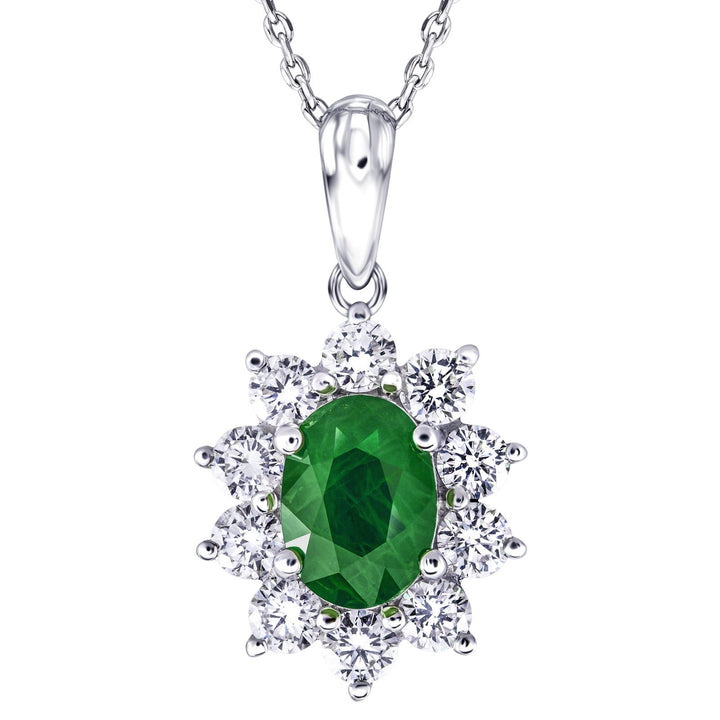
$3,631.00
$6,622.00
Over a carat of deep, entrancing emerald nestled in a carat of G/SI quality, ethically sourced diamonds. Shaped delicately by hand in the UK to our exacting standards to ensure it will sit just so when worn by your loved… read more
Clasp Types Explained
Beyond securing jewellery through proper length selection, knowledge of clasp mechanisms determines both functionality and aesthetic success of any necklace or bracelet purchase.
Modern clasp styles balance durability with aesthetic appeal, offering solutions for diverse jewellery applications. Spring ring clasps remain an economically priced option particularly suitable for lightweight chains and charm attachments. Grasping clasp materials and trends enables informed purchasing decisions, particularly when considering functionality requirements.
Essential clasp categories include:
- Spring-loaded mechanisms (lobster/spring ring) providing secure closure for varying weight capacities
- Decorative systems (toggle/fishhook) enhancing visual appeal whilst maintaining functionality
- Accessibility-focused designs (magnetic/slide) prioritising ease of use
Clasp history reveals an evolution from simple hook closures to sophisticated mechanisms accommodating specialised needs.
Contemporary clasp applications range from delicate chain fasteners to heavy beadwork securements.
Selection criteria encompass durability requirements, aesthetic preferences, and user capabilities, guaranteeing optimal performance across diverse jewellery styles.
Bracelet Styles and Construction Methods
Countless bracelet construction methods exist within jewellery making, each offering distinct advantages for different design goals and wearer preferences.
Threading methods determine structural integrity, with elastic cord enabling stretchable designs as jewellery wire supports closure types like lobster clasps and crimp beads. Bracelet materials range from lightweight acrylic to classic glass beads, each affecting durability factors and comfort levels.
Pattern creation involves alternating colours and shapes in predetermined sequences, as layering techniques stack multiple strands using spacers for dimensional effects. Charm bracelets feature sterling silver elements in various motifs, allowing personalisation through birthstone additions and custom stamped pieces.
Structural techniques include crimping mechanics for securing wire ends and welding for permanent metal joints.
Specialised styles incorporate unique elements—level bracelets integrate functional tools through eye pins and adhesive bonding, as welded metal designs offer maximum durability through precision-fused stainless steel construction.
Baguette Diamond Bangle 1.50ct G/SI Diamond in 18k White Gold
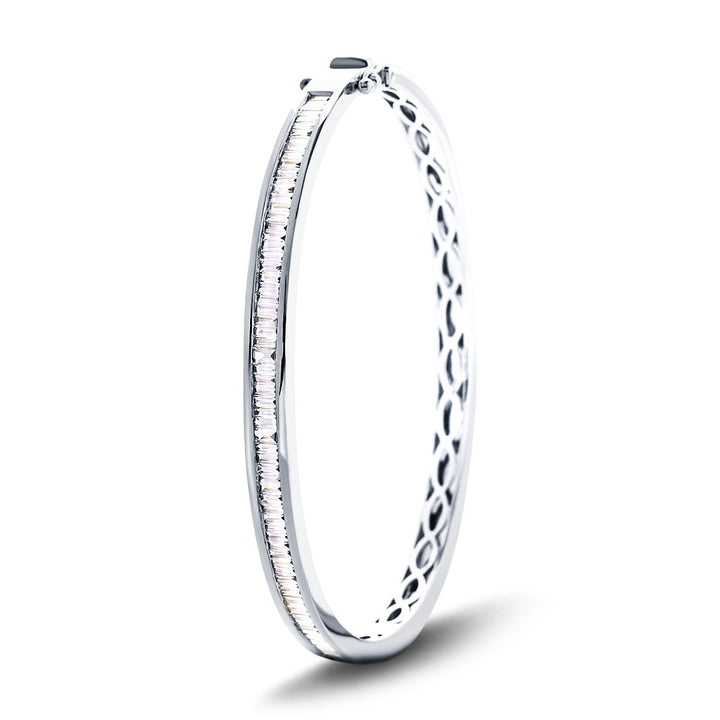
$6,246.00
$9,670.00
This is a beautiful piece of jewellery that is made with the finest materials. The 1.50ct of G/SI Diamonds is set in a beautiful white gold bangle 18k piece. It is a classic style that is sure to make you… read more
Watch Components and Technical Features
As bracelets represent jewellery's decorative artistry, watches merge aesthetic design with precision engineering through intricate internal mechanisms.
Watch movements define timepiece functionality through distinct component functions and energy reserve capabilities. Comprehending these technical aspects reveals the sophistication behind timekeeping.
Essential movement types include:
- Mechanical movements requiring manual winding with 40-80 hour reserves
- Automatic winding systems using rotors activated by wrist motion
- Quartz accuracy achieving +/-10 seconds yearly through crystal oscillators
- Escapement types regulate energy release as mechanical precision depends on hundreds of precisely calibrated parts. Modern innovations include Spring Drive technology combining mechanical mainsprings with quartz regulation for enhanced accuracy.
Luxury craftsmanship enhances these mechanisms through hand-finishing and movement innovations like silicon components and co-axial designs.
Premium complication features such as tourbillons and chronographs showcase technical mastery beyond basic timekeeping, distinguishing haute horology from standard production.
Comfort Features and Wearability Terms
As watches showcase engineering precision through movement mechanics, jewellery comfort features determine daily wearability through thoughtful design elements that prioritise the wearer's experience.
Comfort fit rings incorporate domed interiors that minimise friction reduction against skin, whereas convex profiles enable smooth knuckle passage.
Ring ergonomics extend beyond basic sizing—precision-measured shank width alternatives distribute pressure evenly, promoting circulation improvement during extended wear.
Stone settings in half-eternity designs balance aesthetic appeal with practical daily comfort by reducing bulk.
These wearability benefits stem from careful construction techniques, including rounded edges and balanced weight distribution.
Modern tension settings eliminate traditional prongs, creating smoother surfaces that prevent fabric snags while maintaining secure stone placement.
Design versatility allows customisation across metal thicknesses and finishes, guaranteeing both visual seamlessness and functional advantages.
Modern jewellery manufacture prioritises these comfort-focused details, transforming rings from mere decorative pieces into ergonomically optimised accessories suitable for continuous wear.
20 Baguette Diamonds Half Eternity Ring 0.75ct 18k Yellow Gold 4.0mm
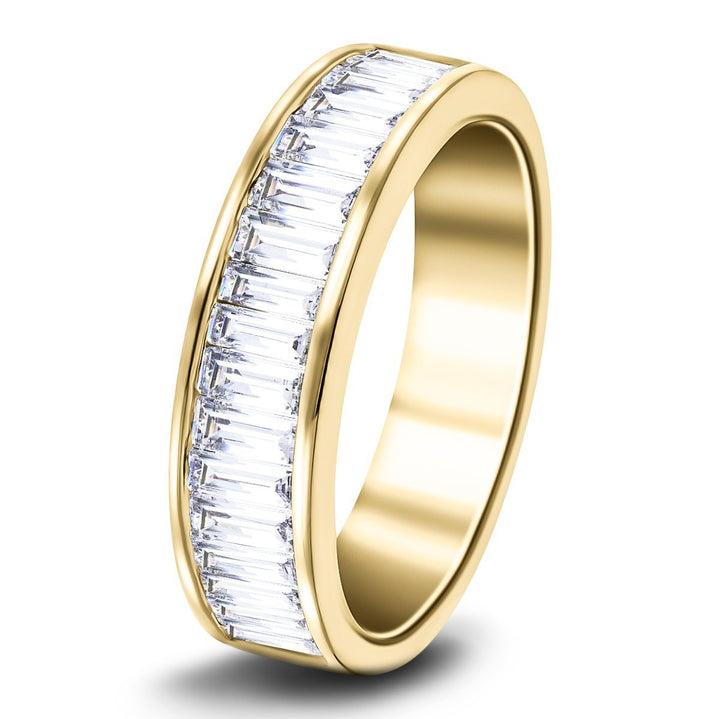
$1,847.00
$2,855.00
A solidly imposing half eternity ring still retains sensual femininity with the sparkle of three-quarters of a carat of hand-cut, baguette-shaped diamonds in a channel setting on a glossy 4.00mm width yellow gold band. The diamonds used are conflict-free and… read more
Our Final Thoughts About Jewellery Jargon
Grasping jewellery terminology empowers buyers to make informed purchases and appreciate craftsmanship details. From understanding metal purity stamps to recognising precious stone cuts, this specialised vocabulary bridges the gap between consumer confusion and confident selection.
Knowledge of these technical terms transforms shopping experiences, whether you are evaluating diamond clarity grades or identifying chain styles. The jewellery industry's language, once decoded, reveals the intricate art and engineering behind each piece that adorns the human form.
